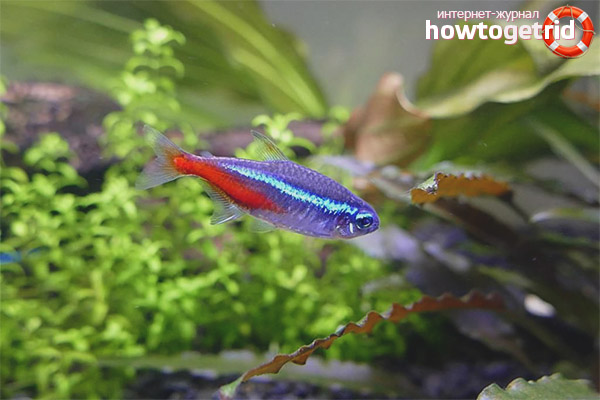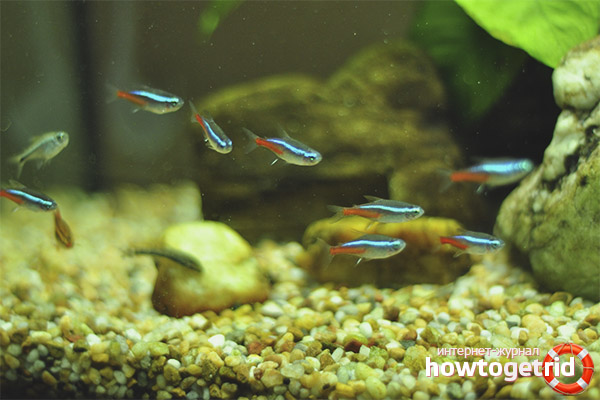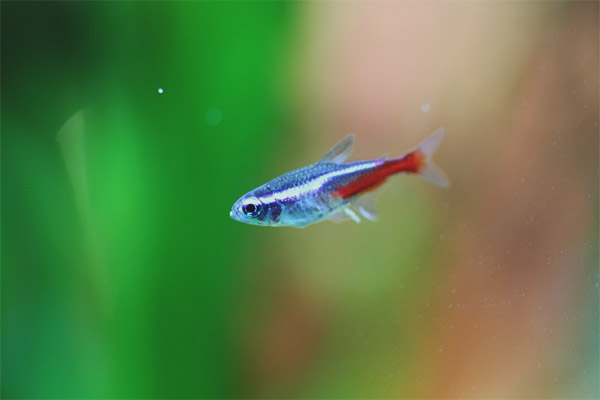The content of the article
Blue Neon - is a fish from the tropics, it is often bought for aquariums. The neon fish has two nicknames, or it is called blue neon or ordinary. This breed belongs to the family haratsionovyh, and lives in South America.
Neons live in calm tributaries of large rivers. They settle in areas with gloomy water and dense plants; sunlight practically does not enter these areas. In nature, fish feed on insects, which are quite numerous in those places where neon fish live.
Neon story
Why neon? The fish stands out for its neon horizontal strip, which runs from the head to the tail. This individual was first discovered by an adventurer in 1934. The Frenchman traveled through the Amazon rainforest, and he accidentally fished out some brilliant fish from the Amazon. The traveler brought his booty to France, he wanted to sell them, and he succeeded!
In 1935, a full-fledged article about neons appeared in a European newspaper. Soon the fish began to colonize aquariums of Europeans, many were delighted with the iridescent neon fish. To this day, there are people who admire the overflowing elegance of neon.
Habits in the aquarium
The fish lives in the aquarium for about 4 years. Prefers temperatures from 20 to 24 degrees with soft and sour water. She also needs good filtration, the best option would be to use a canister filter, which does not give flow and cleans the water space from all sorts of harmful bacteria and pollution.
Sexual features
During spawning periods, it needs very soft water and elevated temperature, reaching up to 26 degrees with a plus sign. Remember that the higher the degree, the faster the fish ages!
Sexual maturity of neons occurs in 6 - 8 months, but sometimes a little earlier. The female is able to sweep up to 150 eggs.Fry appear from eggs after 5-10 days.
Females are larger than males, although this is not visible visually. The female reaches 4 centimeters in length, and the male grows to 3.5 centimeters. The most noticeable difference is the belly, which in females is full and round.
Relationship with other fish
As a rule, blue neons stay on the bottom and in the middle water layer. Neons do not harm plants and are terribly afraid of large fish, as they can swallow them, for example, cichlids are able to eat neon fish.
Neons love peaceful fish, but predators obviously do not like them, as do large waterfowl. Although neon individuals are very brisk, they become vulnerable at night because of their bright glare.
Appearance

The body is quite flexible and overly narrow, with the overflowing, luminous stripes running from the sides. Just below the famous strip is a red stripe, it goes from the middle of the body and reaches the tail. Fins are colorless and transparent.
At night, neon loses its bright color, the fish itself becomes less active at night. Also, the fish can lose their condition during stressful situations or after them.
Dangerous neon disease
Plistophorosis is the most common disease. Sick fish loses color, this is especially noticeable on the neon strip, which begins to dim. Also, the fish loses coordination and stops moving to the beat, in some cases, refuses to eat any food.
Cure plistoforoz currently impossible. If one of the fish gets sick, then it is necessary to destroy all the animals in the aquarium, or put them in some quarantine place. After that, the soil needs to be replaced, and the entire aquarium and all water accessories should be thoroughly disinfected.
Preferences
A beginner is advised to buy neon specimens, since they do not need to be carefully looked after. Fish can be kept in any aquarium, even a miniature vessel. However, fish do not adapt very well to drastic changes, therefore, they should not be immediately launched into a new aquarium. First you need to wait until all parameters are stabilized, and only after starting the housewarming.
Increase water hardness and change other parameters need to gradually. Although the fish do not like changes, but if they are introduced a little bit, then nothing terrible will happen.
Neon loves flocks, for this reason it is necessary to populate five or six neon fish at once into the aquarium, and some knowledgeable aquarists advise even more, up to 20 pieces.
Light should be at a minimum, like the luminous decorations in an aquarium. The fish do not like bright colors, it is best for them to lay Gothic soil and highlight dark, dense vegetation. However, you must also give her a place to swim, otherwise, the fish will not feel very comfortable and show aggression.
Nutrition
The fish loves live food: small raspberry, small daphnia, tubules, cyclops will do.
In general, neons are omnivores, they taste both live and dry food, and even feed substitutes. It is important to remember that neons do not pick up food from the bottom, for this reason you need to let go of small portions of food and not use frozen, easily sinking feeding.
To feed the best versatile food, rich in vitamins and proteins, this is a very important rule for tropical fish. The fact is that the feeding forms the color of the fish, if fed it in a versatile way, then it will be enough for everything, which means that the color will be very bright and beautiful.
Mature fish do not need a lot of food, they can be fed once a day, believe me, this is done for their own good. Neons can become obese - they have a predisposition to it! If you feed them often, unfortunately, this can lead to premature death.
Breeding

It is difficult to breed a fish in any household vessels, because it is necessary not only to create conditions, but also to successfully pick up a pair. The fact is that the male and the female breed only when they experience mutual attraction to each other.
To propagate a neon fish, you need to create a special spawning aquarium with 24 degrees of heat. After the start of mature individuals, it is necessary to gradually increase the level of illumination in the spawning ground, with time the fish will start spawning. In addition, to increase the speed of the process, we advise you to increase the feeding of producers, the best food during spawning is a bloodworm.
In the spawning should not be anything superfluous, only small plant decorations for the comfort of the fish.
Amazing fact! Females in aquariums produce more eggs than in nature. If in nature, on average, the female lays about 35 eggs, then in the aquarium, this figure reaches 150.
Be careful: neon caviar does not adapt too well to changes in lighting and changes in water parameters. Females and males after spawning can eat their own eggs, so you need to put a separator cage at the bottom and do everything possible so that the mature individuals do not get to the eggs or hatched fry.
It will be a day after spawning, and at this time the larvae will begin to appear from the eggs. In a week all the fry will calmly swim along the spawning grounds, and look for food. Starter food for fry is boiled egg yolks, rotifers and ciliates.
It will take a few more weeks, and the fry will begin to eat Artemia, and in a month they will look like mature fish, including the corresponding color. Filters for fry will not be needed, as they are of scanty size, which means they will immediately die with the introduction of the filter mode.
Popularity
Neon for a short time could appeal to both beginners and experienced aquarists.These charming and bright creatures will become a real decoration in any aquarium; they will not only attract the attention of others, but also will not harm vegetation and other inhabitants of the water kingdom.
Plus many: neon slaves unpretentious, has a peace-loving character and has a unique bluish overflow line with a bewitching red addition.
Video: aquarium fish neon











To send